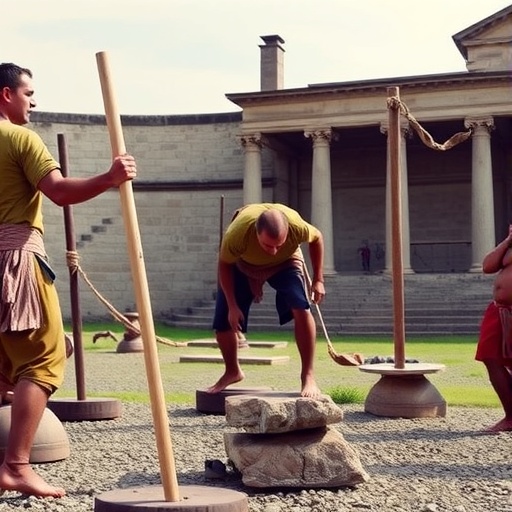In a monumental exploration of ancient craftsmanship, researchers M. Abdelbar and A. ElFetni conducted an intricate analytical study of a Roman bronze steelyard balance found in Leptis Magna, Libya. This steelyard, a crucial instrument used for weighing goods, offers a remarkable glimpse into the advanced manufacturing techniques prevalent during the Roman era. With archaeological relics often revealing layers of civilization, this particular analysis delves deep into not only the creation of the balance but also its subsequent degradation over time due to burial conditions.
The study begins by contextualizing the significance of the Roman steelyard, an instrument that was not merely a tool of commerce but also a reflection of Roman engineering prowess. These devices enabled merchants to weigh their goods accurately and efficiently, which was essential for trade and economic stability in Roman territories. The authors elaborated on the historical importance of Leptis Magna, a vibrant trading hub in North Africa, where this steelyard was unearthed, showcasing the interlinking of commerce and technological advancement.
In this investigation, the researchers employed advanced analytical techniques to ascertain the precise manufacturing methods utilized in crafting the bronze steelyard. They meticulously examined the materials, including the copper alloys that constituted the bronze, shedding light on the metallurgical knowledge of the Romans. This metallurgical analysis provided insights into how the Romans could produce durable and reliable instruments capable of withstanding the rigors of daily use while also revealing the geographical origins of the raw materials used.
Furthermore, the manufacturing techniques were dissected, illustrating the potential workshops and processes that may have existed in Leptis Magna or other significant Roman centers. The authors proposed hypotheses regarding the tools and techniques that ancient artisans might have employed. Their analytical approach included the study of casting methods, surface treatments, and the mechanical properties of the bronze, creating a comprehensive picture of Roman engineering skills that continues to astonish modern researchers.
As the study progressed, an essential aspect highlighted was the effect of burial conditions on archaeological artifacts, particularly the steelyard balance. The authors provided a detailed account of how environmental factors, including soil composition, moisture levels, and microbial activity, contribute to the degradation of metal artifacts over centuries. In this context, they explored the corrosion processes that impacted the steelyard’s integrity.
The balance’s degradation not only posed challenges for its preservation but also for the interpretation of its historical and technological significance. Abdelbar and ElFetni meticulously documented the corrosion patterns observed on the steelyard, employing cutting-edge imaging techniques to visualize these changes. This aspect of their research underscores the importance of interdisciplinary approaches in archaeology, where collaboration between scientists and historians enhances our understanding of ancient artifacts.
The findings from this research contribute significantly to the field of archaeological science, particularly in understanding the workings of ancient economies. The steelyard balance serves as a testament to the sophistication of Roman trade systems, providing evidence of regulated weights and measures. This research sheds light on the broader implications of standardized measurements that were crucial in facilitating commerce across vast distances in the Roman Empire.
Additionally, the authors touched upon the cultural implications surrounding this artifact. The steelyard is not merely a functional object; it embodies the societal values placed on trade, craftsmanship, and economic strategy in Roman times. In a world where trade routes connected diverse cultures, such tools helped forge relationships and fostered commercial growth, making this analysis of the balance a topic of broader interest beyond just a historical artifact.
Through their analytical approach, the researchers encourage a re-evaluation of how we perceive ancient technologies. Rather than viewing them as primitive, this study highlights the ingenuity and advanced skills present in Roman metallurgy and trade practices. It raises essential questions about what other artifacts might reveal about the ancient world when subjected to modern scientific scrutiny.
In conclusion, the analytical study of the Roman bronze steelyard balance from Leptis Magna orchestrated by Abdelbar and ElFetni provides an illuminating lens into the complexities of Roman trade and manufacturing techniques. Their work not only serves as a significant addition to the archaeological record but also emphasizes the need for continued exploration of historical artifacts through innovative analytical methods, thus bridging the past with present scientific inquiries.
Such research not only preserves knowledge of ancient civilizations but also inspires new generations of archaeologists and scientists to delve into the mysteries of the past, ensuring that the legacies of our forebears are neither forgotten nor overlooked in the rapidly advancing world of modern science.
This study reminds us that every artifact, including the steelyard balance, carries within it stories of human innovation, resilience, and the relentless pursuit of progress that has defined our collective history.
Subject of Research: Roman bronze steelyard balance from Leptis Magna
Article Title: Analytical study of a Roman bronze steelyard balance from Leptis Magna, Libya: manufacturing techniques and burial degradation.
Article References: Abdelbar, M., ElFetni, A. Analytical study of a Roman bronze steelyard balance from Leptis Magna, Libya: manufacturing techniques and burial degradation. Archaeol Anthropol Sci 17, 227 (2025). https://doi.org/10.1007/s12520-025-02342-z
Image Credits: AI Generated
DOI: https://doi.org/10.1007/s12520-025-02342-z
Keywords: Roman steelyard balance, Leptis Magna, manufacturing techniques, burial degradation, archaeological science, metallurgical analysis, corrosion, ancient trade, historical artifacts, engineering skills.




